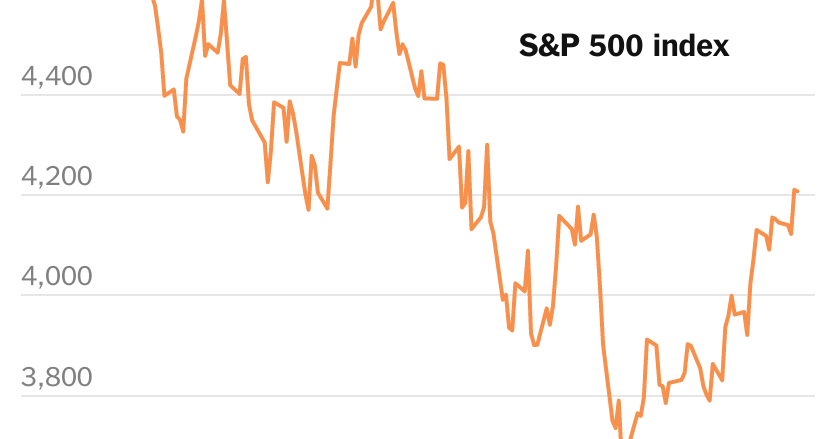The stock market has notched the year’s best stretch of gains, as investors take comfort from early signals that inflation is slowing and the economy is holding up.
The S&P 500 rose 1.7 percent on Friday, taking its rise for the week to 3.3 percent and marking its fourth consecutive positive week, a feat it had not achieved since October. The index is now more than 16 percent higher than its low point in June, though it remains 10 percent lower for the year.
The rally stands in stark contrast with the first half of the year, when Wall Street suffered its worst start in half a century, as the war in Ukraine, soaring energy costs, rising interest rates and rapid inflation galvanized investors’ fears about the health of the economy.
Federal Reserve officials have suggested that their campaign of interest rate increases to tame inflation is not yet done. But some investors see recent economic data as grounds for the central bank to move less aggressively, easing worries that higher borrowing costs could push the economy into a severe downturn.
Inflation F.A.Q.
Inflation F.A.Q.
What is inflation? Inflation is a loss of purchasing power over time, meaning your dollar will not go as far tomorrow as it did today. It is typically expressed as the annual change in prices for everyday goods and services such as food, furniture, apparel, transportation and toys.
“The peak of freaking out about inflation and interest rates is done, and we are looking at something that is not quite as dramatic,” said Michael Purves, the founder and chief executive of Tallbacken Capital.
The latest Consumer Price Index report, released on Wednesday, offered a moment of relief for Wall Street, as inflation slowed to 8.5 percent over the year through July, down from a 9.1 percent pace in the previous month. The data offered an early indication that the Fed’s attempt to rein in inflation may be having an effect.
What’s more, data showing that in July the economy regained all the jobs lost in the pandemic, along with weeks of better-than-expected earnings reports from companies, have assuaged some concern among investors that higher rates, which increase costs for companies, could cut more deeply into corporate America.
The CBOE Vix volatility index, also known as Wall Street’s “fear gauge” because it reflects a sense of investors’ uncertainty over stock market moves, dipped below its long-term average of 20 points this week. The Vix had stayed above that mark since April, so the lower reading could be a sign that investors’ consternation about another lurch lower has subsided.
“We’ve seen a succession of inflationary pressures begin to roll over,” said Patrick Palfrey, a senior U.S. equity strategist at Credit Suisse. He added that this was “forcing” investors to re-evaluate their trading positions.
Bankers said retail investors had helped drive the rally. Sharp rises in so-called meme stocks and an uptick in some cryptocurrencies also point to great participation by individual investors.
“The cornerstone of this is the labor market, and it’s rock solid,” said James Masserio, a co-head of equities for the Americas at Société Générale. “If you don’t have a job, then you are not buying meme stocks.”
Experts also said stock markets were primed to ratchet higher. Investors had scaled back their bets on the market because of uncertainty. The volume of trading has also been low, with many big investors taking vacations through August. As a result, even small amounts of buying interest have helped to lift the market, with momentum building as other investors chased returns.
Understand Inflation and How It Affects You
More than $11 billion flowed into funds that buy U.S. stocks in the week through Wednesday, according to EPFR Global, the most in eight weeks.
But some bankers warned that just as quickly as markets have recovered, they could fall again. Short-term gains are not unusual during periods of protracted losses, known as bear market rallies.
After the S&P 500 peaked in October 2007, it slid more than 50 percent by November 2008 in the aftermath of Lehman Brothers’ collapse. Then the index rose almost 24 percent in a matter of weeks. But the sell-off was not over. The S&P 500 gave up all those gains in early 2009, before bottoming out in March that year.
Mr. Masserio said the Fed’s task of lowering inflation back to its target of 2 percent was akin to turning an oil tanker around: slow and fraught with risk.
“Fundamentally, what had built up in the system is a lot trickier than what we can fix in six months of a shift in monetary policy,” he said, warning that the stock market’s woes may not yet be over.
Stocks are higher because the inflation outlook has improved and the economic backdrop remains supportive. Although expectations are not as dour as they were, there are doubts about how long the rally can last.
“I am bullish on the market, but I am still an anxious and nervous bull,” Mr. Purves said. “We are not out of the woods just yet.”
